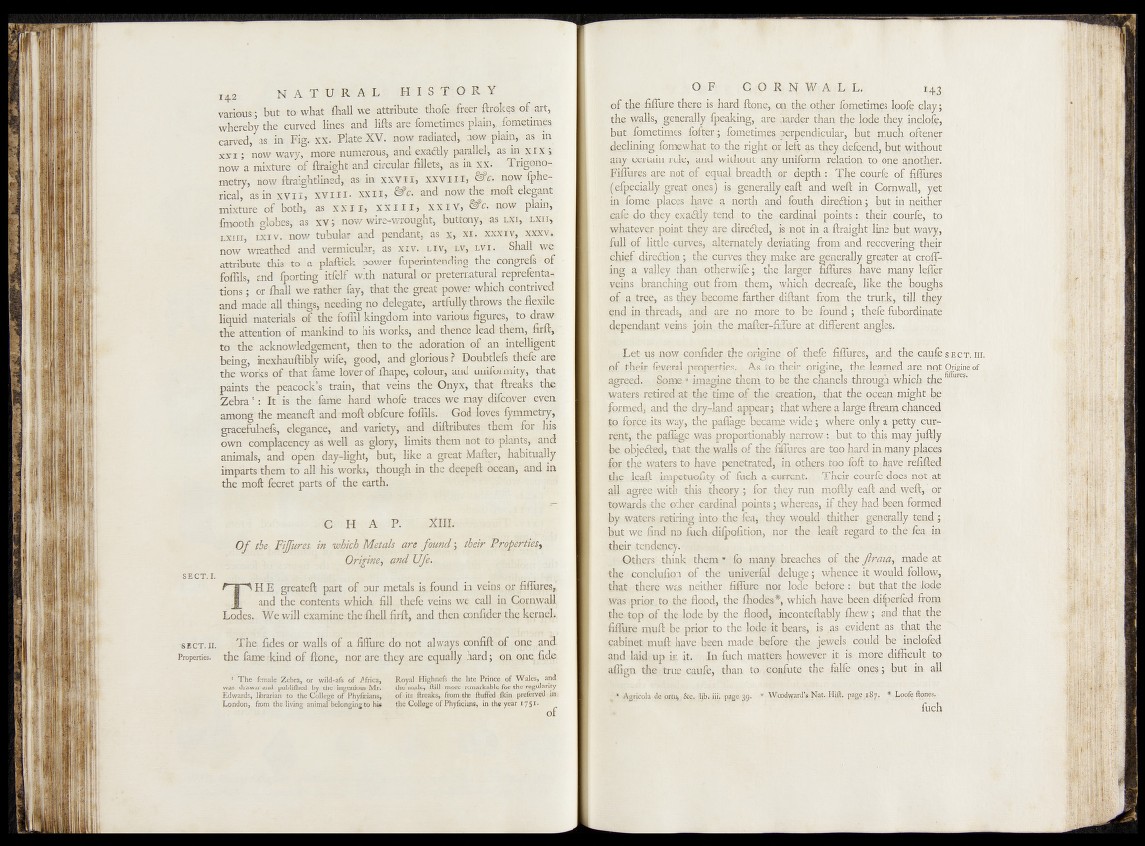
SECT.I.
vtabas!', btat j -to what ffiall we; attribute freer: ftrdfSSt o f ; ^
vffereby the curved lines and lifts ate fometiirnes plain,, fo®e&njp
c^veffifrasriff.1%d9Filter.X%is®wJfcdMeck a^ in
x-si ; nosy wavy, m ^ e nuhietous, and; exaaftly pafalleh axfe 3£ix*
now a mixture of ftraight and circular ®qfe, as in. XX, Trigonometry,
SECT. II,
Properties.
now lferightlimed,; as’ in xXTJI, XXVI I I > ^ . now C le rical,
^ in - x v ii ,- x v i i i - x x i i , & c . and now the moft elegant
mixture of both* as XXI I , X X1 1 1 , XX jj V, & c , ®pw plahi»
fmooth globes, as x v i now wire-wrought, buttony, as lxi, lxii*
LXIIi, lxiv. now tubular and pendant, as x , x i . xxxjv, xxxv.,
now wreathed and vermicular, as xiv. liv, -l.v, lvi. Shall we
attribute this to a plaftick power fuperintending the congrefs of
foffils, and fporting itfelf with natural or preternatural reprefenta-
tions * or fhall we- ratherfay, that the great power which contrived
and made all things, needing no delegate, artfully throws ftejlex%
liquid materials of the foffil kingdom into various figures, to draw
the attention of mankind-to his works, and thence lead them, firft,
to the acknowledgement, then to. the adoration of an intelligent
being, inexhauftibly wife, gbod, and glorious;? Doubtlefs thefe are
the- works of that fame layer <£ihapei eolotffi^ land iMformity, that
paints the peacock’s train, that veins the Onyx, Aafefbie&ks th^
Zebra* : It is the lame hand whofe traces we may\dtfcaver eyen
among the meaneft and moft obfcure foffils. Gocbfoves. fymmetry,
graceiulnefs, elegance, and variety, and diftribufies them for Ilia
own complacency as well as glory, limits them not td plants, and
animals, and open day-light, but, like a great Mailer, habitually
imparts them to all bis works, though in the deepeft ocean, and in
the moft fecret parts of the earth.
C H A P. XlII.
O f the■ Fijfures. in which Metals are found > their Properties,
Origine, and Ufe. |
T H E greateft part of our metals is found in veins.or fiftures,
and the contents which fill thefe veins we call in Cornwall
Lodes. We will examine the fhell firft, and then confider the kernel;
The fides or walls of a fifliire do. not always confift of one and.
the fame 'kind of ftone, not are they are equally hard; on one, fide
1 The female Zebra, or wild-aft of Africa,
Royal Highnefs the late Prince of Wales, and
was drawn; and publifhed by the1 ingenious Mr.
the male, ftill more remarkable for the regularity
Edwards, librarian to the College of Phyficians,
of-its ftreaks, from, the fluffed lkin preferved in
London, from the living animal belonging to bis
tjic College of Phyficians, in the year 1751>
of
of the fifliire thgger|lsjhard ftpnf,; pp, tfre, other fpmetinpep loofe
th | g fn ^ ^ fp e ^ k in g , are.; haffifr thaq ffie lodg they, inp)qf?,
but fometimes fofter; fometimes perpendicular, but much oftener
declining fomewhat to the right or left as, they defcend, but without
any certain rule, and without any uniform relation to one another.
Fiffures are mot of equal breadth or depth : The courfe of fiffurfs
jigfpec-ially great qugs,) js. generafiy^ft, aqdj weft in Cornwall, yet
in fome; jpfry?gs have a, nprth ^ d .fitutfi ffitf^jiipn > fepf nejtfier
cafe do they exactly tend to the cardinal points: their courfe, to
whatever point they are directed, is not in a ftraight line but wayy,
full of little curyes, alternately deviating from and recovering their
chief direftion; the curves they make are generally greater at crofting
a valley than otherwife; the larger fiflures have many lelfer
veins branching put from them, which decreafe, like the boughs
of a tree, as they become farther diftant from the trunk, till they
Gild in threads, and are no more to be found; thefe fubordinatc
dependant veins join the mafter-fiffure at different angles.
; Let us now confider the origine of thefe fiflures, and the caiife se c t . in.
of their feveral properties. As to their origine, the learned are not Origine of
agreed. Some-“ imagine them to be the chanels through which the
Waters retired at the time of the creation, that the ocean might fie
formed, and the dry-land appear; that where a large ftream chanced
to force its way, the paffage became wide; where only a petty current,.
the paffage was .proportionally narrow: but to ‘this may juftly
be objected, that the walls of the fifiures are too hard in many places
for the waters to have penetrated, in others, too foft to have lefifted
the leaft anpetuofity of fiich a current. Their courfe does not at
all agree with this theory; for they run moftly eaft and weft, or
towards; ;the other cardinal points ;, whereas, if they had been formed
by iwater-s retiring into the fea, they would thither generally tend ;
but we find no fiich dijpofition, nor the leaft regard to the fea in
their tendency.i| |
Others think th em” fo many breaches of the firata, made at
the conplufipn of the univerfal deluge ; whence it would follow,
that there was neither fifliire nor lode before : but that the lode
Was .prior , to the flood, the fliodes which have been diffieifed from
the top of the lode by the flood, inconteftably fliew; and that the
fifliire muft be prior to the lode it bears, is .as evident as that tfre
cabinet muft have been made before the., jewels could be inclpfed
apd laid up in it. In fueh matters however it is more difficult to
affign tlie tme caufe, than to confute the falfe pj)g§; but in all
® 'Agricola; &c'., »Kb.iiii,. ppgc, 35. ,f: W flo d yw jd ^ l^EM . page,18-7;
Sllfrjqh -